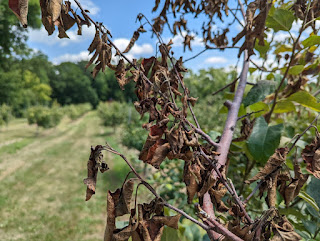 |
| Photo: The Minnesota Apple Growers Association held their annual farm tour at the Horticulture Research Center on Friday, July 22. |
Author: Annie Klodd, Extension Educator, Fruit and Vegetable Production. kloddann@umn.edu
This week's update includes apple pest management, grape veraison, raspberry and blueberry harvest seasons, and day neutral strawberry troubleshooting.
First, are we in a drought again?
Many areas of Minnesota are getting a welcome break after last year's drought, and the metro area is experiencing deja vu from last year. The Drought Monitor map below shows that areas southwest of the metro are in moderate or severe drought, while northern Minnesota has no drought conditions.
Some of us are getting tired of irrigating, aren't we?
At least, one nice thing about the lack of rain is a lack of disease pressure.
 |
| Drought Monitor map for Minnesota, showing a range of drought intensity from "none" to "severe" across the state. https://droughtmonitor.unl.edu/CurrentMap/StateDroughtMonitor.aspx?MN |
Apples
 |
| Apples ripening and expanding west of the Twin Cities on July 27, 2022. Photo: Annie Klodd |
- Codling moths have 2 generations of adult moths per season. The 2nd generation is currently in flight. If effective insecticides were applied during the first flight, you may see very few moths this week, and vice versa.
- This is peak apple maggot season. Check traps and consider spraying if the fly numbers are over the economic threshold (1 fly per week per unbaited trap, or 5 flies per week per baited trap). Unbaited vs. baited refers to whether or not you're using the white plastic scented lures above your red sticky spheres.
- Read this article for insecticide options for codling moth and apple maggot
- Protect beneficial insects by only spraying above the economic threshold and avoiding broad spectrum insecticides if possible.
- This is a good time to scout for fire blight, apple scab, and cedar apple rust, because the symptoms have become easy to spot by this time in the season.
 |
| Apple tree shoots infected with fireblight exhibit a "shepherd's crook" or downward bend on the tips. Photo: Annie Klodd |
Grapes
 |
| A vineyard crew completed lateral removal prior to bird net application in a week or two. Photo: Annie Klodd. |
Marquette and possibly a few other varieties just entered veraison this week.
I have received questions about when to apply bird netting. It can work to apply netting now, or wait a couple of weeks. There are pros and cons to weight out:
- Benefits of applying netting early: Birds begin noticing fruit once it turns red. Early netting minimizes the risk of bird damage once fruit develops color.
- Challenges of apply netting now (at veraison): Once the netting is on, we no longer have easy access to the vines. Finish any shoot tucking, leaf pulling, shoot removal, or other canopy management before the netting goes on. Additionally, more shoots may grow through the net the longer it is on.
- Bird netting is not known to impact spray penetration, so that should not be a limiting factor in the decision of when to apply it.
Raspberries
Summer-bearing season is wrapping up just as early fall-bearing raspberry varieties are beginning to ripen. While the summer-bearing season was low-yielding for some due to the hot weather, I am hopeful that the fall season will be more productive.
Dead canes? If you see dead or wilted raspberry canes, it could be caused by a number of issues such as: Cane blight, leaf blight, raspberry cane borer, anthracnose, and phytophthora. To narrow down the options, look at the entire length of the cane and relate the symptoms to descriptions in this article. If you feel stuck, send a sample to the Plant Disease Clinic for formal diagnosis before treating the problem.
Strawberries
 |
| Photo: Three research projects are currently happening with day neutral strawberries at the UMN research farm in St. Paul. |
Day neutral strawberries should be hitting their stride. Peak production occurs in August or September in Minnesota, and fruit continues to produce through the fall.
Some growers have reported small fruit or lack of flowers. It is hard to say for sure what has caused this, but it may be the hot day and nighttime temperatures recently. Other factors include excess nitrogen that promotes vegetative growth over reproductive growth, under-watering, and using black plastic instead of white-on-black plastic (can cause excessive temperatures).
For June-bearing strawberries, renovation should have ideally been completed in the last three weeks. If you have not had a chance to renovate yet, complete this step as soon as possible. https://extension.umn.edu/strawberry-farming/strawberry-end-season-renovation
Blueberries
This is peak blueberry harvest season! Reports from growers are that the plants are productive this year, providing high yields for the U-pick customers who are flocking to the fields. The main pest now is spotted wing drosophila. SWD pressure is much lower if all ripe fruit on the plants are being picked every 1-2 days, which is typically the case on U-pick farms. There is not much else to say about blueberries at this time; please feel free to contact me with specific questions.
Comments
Post a Comment